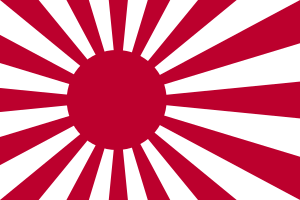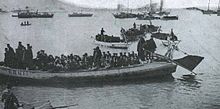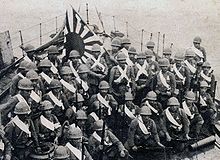Ground Forces (Imperial Japanese Navy)
|
Ground forces of |
|
|---|---|
 Kyokujitsuki (flag) of the Imperial Japanese Navy. It was introduced in 1889 and consists of the Japanese national flag , supplemented with 16 stylized rays. |
|
| active | 1870 to 1945 |
| Country |
|
| Armed forces |
|
| Armed forces | Ground Forces (Imperial Japanese Navy) |
| Branch of service |
Marines , engineering corps , antiaircraft |
| Type |
Infantry , armored forces , paratroopers , guards , pioneers, engineering corps |
| Butcher |
Second Sino-Japanese War Second World War |
| commander | |
| Supreme command | Imperial Japanese Navy |
The ground forces of the Imperial Japanese Navy ( Japanese 海軍 陸 戦 隊 Kaigun riku sentai ) were a branch of the Imperial Japanese Navy . The origins go back to the founding of the Japanese Marines in 1870. From 1929 onwards, there was a regrouping and the associated establishment of units or departments for operational use in amphibious landings, supporting parachute missions in enemy territory, anti-aircraft defense, guarding naval bases and naval facilities, pioneering and communications services, military police and civil engineering departments. The most famous units to emerge from the Imperial Japanese Navy's ground forces were the Navy's Special Landing Forces , which participated in numerous missions during the Second Sino-Japanese War and the Pacific War .
Organization 1870–1928

Just one year after the Imperial Japanese Navy was founded, she decided in 1870 along the lines of the British Royal Marines own Marines set up and called this branch of service also Marines ( 海兵隊 , Kaiheitai ). The Japanese marines were subordinate to infantry and artillery units.
The Japanese marines took part in the suppression of the Boxer Rebellion and in the Russo-Japanese War , including the landing in the Bay of Chemulpo and the siege of Port Arthur , in which they provided artillery men with the latter.
Organization 1929–1945
Navy ground forces were under either one of the four naval districts or one of the five guard districts within and outside of the empire.
Marine Districts
The Japanese Empire was divided into four naval districts: these were Yokosuka , Kure , Maizuru and Sasebo . Each of these districts was able to independently carry out recruiting, replacement of troops, the formation of new troops, establishment of training facilities and the defense of their districts. The most important ground troop units in the districts were:
- Civil Engineering Department ( Japanese 設 営 隊 Setsuei-tai )
- Naval Base Units ( Japanese 根 拠 地 隊 Konkyo-chitai )
- Guard units ( Japanese 警備 隊 Keibi-tai )
- Defense units ( Japanese 防備 隊 Bōbi-tai )
- Navy-air groups
Guard districts
Imperial Japanese Guard Districts were inside and outside the Empire. They were divided into Ominato , Osaka , Chinkai , Takao and Hainan and were structured in a similar way to the naval districts, but did not contain any naval bases, naval barracks or training facilities. The guard districts comprised the following units:
- Civil Engineering Department ( Japanese 設 営 隊 Setsuei-tai )
- Special base units ( Japanese 特別 根 拠 地 隊 Tokubetsu-konkyo-chitai )
- Guard units ( Japanese 警備 隊 Keibi-tai )
- Special landing forces of the Navy ( Japanese 特別 陸 戦 隊 Tokubetsu riku sentai )
- Defense units ( Japanese 防備 隊 Bōbi-tai ), only used within the empire
- Other staff
Administrative units
Ground forces of the navy outside the empire were subordinate to the naval commanders in the respective areas. Fleet ground forces were strictly divided into administrative and tactical units.
Base Armed Forces
The base armed forces ( 根 拠 地 隊 Konkyo-chitai ) were subordinate to the fleet commanders and were assigned to smaller bases for the administration of the ground and naval forces. With this they took over the function of the fleet headquarters in remote areas. In addition to these duties, base armed forces assumed limited tactical responsibilities. This included defense tasks, communication links and securing the waterways. In areas close to the front, the defense tasks assumed considerable proportions. If necessary, base armed forces were provided for supply, construction, repair and medical care.
Fleet maintenance units
Fuel depots, construction and repair units, as well as all other administrative and service units were part of the fleet maintenance units. The tasks of these units overlapped with those of the Konkyo-chitai mentioned above . Fleet maintenance units were, however, stationed exclusively in fleet headquarters where base armed forces did not operate.
Telecommunication units
The telecommunication units ( Japanese 通信 隊 Tsūshin-tai ) established the communication between their locations and other naval bases, ships at sea and Japan.
military police
The military police of the Imperial Navy was called Tokkeitai ( Japanese 特警 隊 ). Its official name was Special Police Corps ( Japanese 特別 警察 隊 Tokubetsu-keisatsu-tai ). Their tasks also corresponded to those of a secret police , making them the counterpart to the military secret police of the Imperial Japanese Army , the Kempeitai .
Tactical units

Special base units
Special base units ( Japanese 特別 根 拠 地 隊 Tokubetsu-konkyo-chitai ) were assigned to guard districts and fleets. They were stationed either in naval headquarters or close to the front and had mainly tactical combat tasks. For this purpose, they were assigned guard units , special landing forces of the Navy or other combat units.
Guard units
Guard units ( Japanese 警備 隊 Keibi-tai ) were mainly assigned to base units and special base units . Their main tasks were the fortification and defense of land and sea fortifications. If necessary, if airfields fell in their assigned area, they could also defend them. Other tasks included guarding prisoners, pacifying the occupied population and enforcing Japanese laws in the occupied territories.
Navy special landing forces
The Special Landing Forces of the Navy ( Japanese 特別 陸 戦 隊 Tokubetsu riku sentai ), SLKM for short, were the naval infantry of the Imperial Japanese Navy. In English they are called Special Naval Landing Forces , or SNLF for short. At the beginning of the Pacific War their task was primarily to carry out landing operations with supportive air landings. The SLKM provided the naval parachute troops ( Japanese 日本 海軍 空 挺 部隊 Nippon kaigun kūtei butai ) from their own ranks. In the further course of the war, the SLKM largely took on defense tasks. Initially equipped with infantry weapons, light tanks and light guns, the SLKM was gradually equipped with heavier weapons.
Anti-aircraft defense units

The anti-aircraft defense units ( Japanese 防空 隊 Bōkū-tai ) were assigned by the fleets to the base units , special base units , guard units and SLKM depending on the operational requirements. Bōkū-tai were divided into three types:
- Type A armament: anti-aircraft cannons (Flak) and anti-aircraft machine guns (Fla-MG)
- Type B armament: only anti-aircraft machine guns (Fla-MG)
- Type C armament: anti-aircraft machine guns (Fla-MG) and anti-aircraft machine cannons (Fla-MK up to 30 mm caliber)
Ship anti-aircraft defense units
Ship anti-aircraft defense units were company-strength units with a maximum of 124 men. They were u. a. Convoys assigned to protect them from Allied air raids.
Construction battalions
Construction battalions ( Japanese 設 営 隊 Setsuei-tai ) were mobile, independent units that were equipped with heavy equipment to cope with large-scale construction projects. After Setsuei-tais their training at the Naval districts Civil Engineering Institute had finished, they were assigned to the fleets. These in turn were assigned to the base units , special base units and the guard units for special projects such as the construction of airfields and fortifications.
literature
- Gary Nila, Robert Rolfe, Tony Chong: Japanese Special Naval Landing Forces. Osprey Publishing, Oxford 2006, ISBN 1-84603-100-1 .
Web links
Individual evidence
- ^ Roger Goodman, Ian Neary: Case studies on human rights in Japan. Routledge, 1996, ISBN 1-873410-35-2 , pp. 77 ff.
- ↑ Christopher P. Hood: Japanese Education Reform: Nakasone's Legacy. Routledge, London / New York 2001, ISBN 0-203-39852-1 , p. 65.

